Hyperallergic: A Maine Painter’s Private Realm of Becoming
Take Magazine: Following the Tide
Beer with Painter Interview
Brunswick Arts and Letters: Zig/Zag/Color: John Walker at the Center for Maine Contemporary Art (CMCA)
Painter Tubes Magazine
Boston Globe
The Brooklyn Rail: John Walker: Looking Out to Sea
Hyperallergic: Slip, Sliding Away with John Walker
Two Coats of Paint: Images: John Walker
Art In America (2015): John Walker, Alexandre
Hyperallergic
Artcritical
First Things
Sara Meder
Painters’ Table
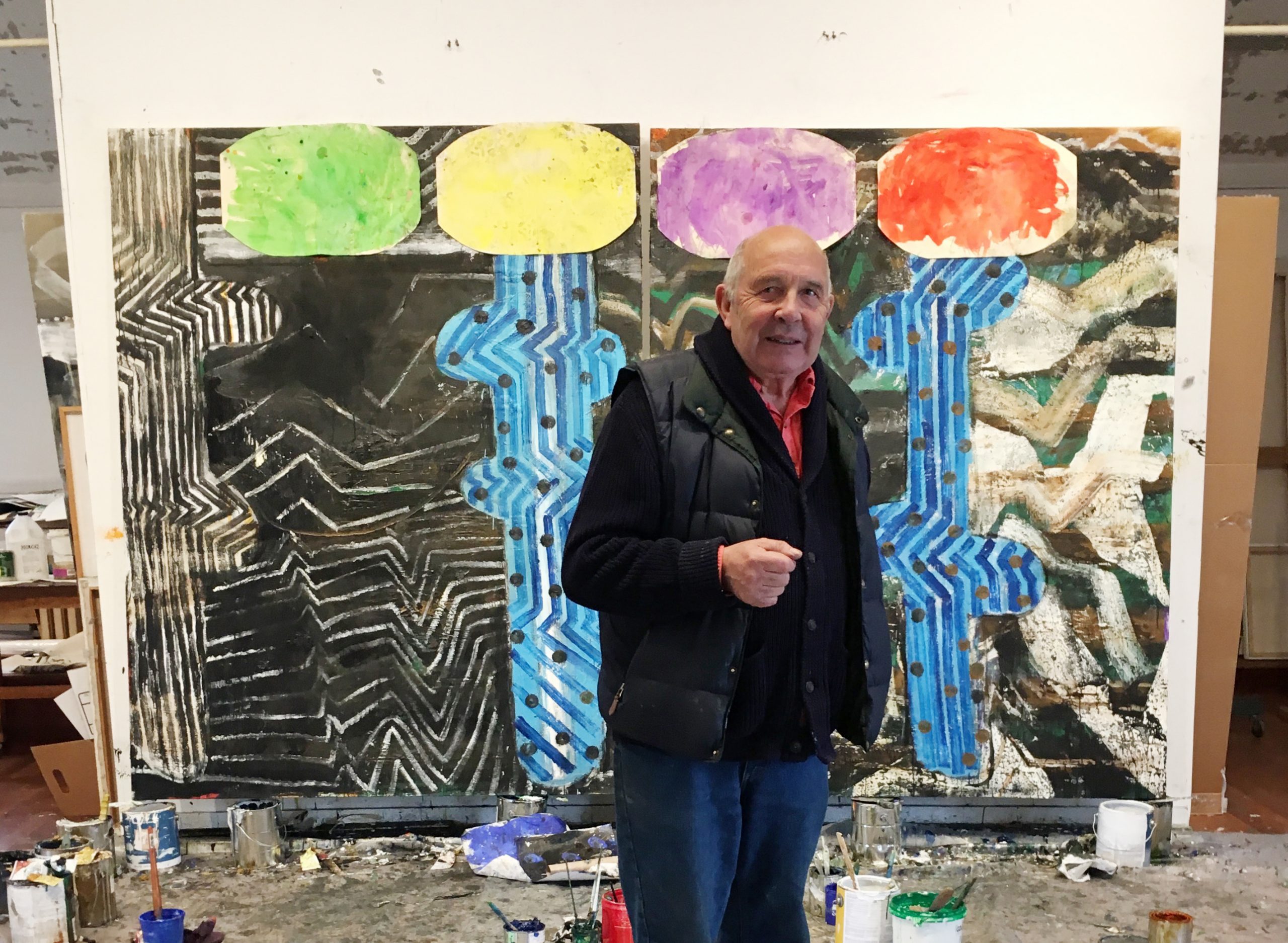
Artists Meryl McMaster and John Walker discuss their Ikon exhibitions, placing emphasis on the artistic representation of homelands and adopted landscapes. At Ikon gallery in 2020.
John Walker discusses his creative process and fascination with the coastline of Maine with curator and art historian Jennifer Same at Sheldon Museum of Art in conjunction with the exhibition “John Walker: Moments of Observation”.
John Walker interview at Ikon Gallery in 2019.
Interview led by John Walker’s former student, Elizabeth Carter Oliver (Boston University MFA ’13, Randolph-Macon Woman’s College BA ’05). Walker’s works are included in the Maier’s exhibition, “One Place, Two Views: John Walker and Kayla Mohammadi” (January 25 – April 14, 2019).
In February 2023 we reached out to friends, colleagues and former pupils of John’s and asked them to send us their anecdotes and photographs of the artist. We have been overwhelmed by the response and have created a working archive here which is being constantly updated.
If you wish to share your story about John, please contact us.
Contact us
“John Walker was one of my first Painting teachers in 1974/75 at The Cooper Union in New York.
The qualities he brought to class changed me as a painter and how to consider what it meant to be an artist. Like John I came from a working class family and had never met an actual artist before coming to college. My experiences with John also greatly influenced the kind of teacher I became years later. In the mid Nineteen Nineties I taught alongside John at Yale.
There were two actions he made back in 1975 that stand out. John told me in class one day to come by his studio, he wanted to show or tell me something, I don’t remember exactly why. I do remember knocking on his door at the appointed hour. John opened the door, handed me a big roll of really nice slick coated paper and said something to the effect of “ now go make something “ and sent me on my way. He knew the kind of paper was what I needed to make a real move in my own work. This all took place at the door; he never had me in his studio. I channelled this experience to my own version. Over the 25 years I taught at Yale and the 20 years I ran the Yale Norfolk summer school, I would often leave little packages of the right supplies outside the studio doors of students that I believed could use them. I would always tell them it grew from that generous gesture of John to me. I think these small gestures were some of the most important pieces of “wisdom” I ever passed on.
The other monumental gesture John made was he drew from the model in class with us. The idea that we too were “artists “ and even someone at his level would work alongside us as the Professor was something alien back then. I remember he looked at his drawing and mumbled in that English accent” it’s not very good “ and ripped it up. John was having a show at MOMA at the same time; I remember he drew on the walls of the museum. Back then the relationship of the teacher and student was very different, in my mind it was similar to Art in a museum, it was separate and seen in the historical past. He showed us it was ever present, hard work and never ending work.
As a contrast, Adja Yunkers ran another class I had at the same time. Basically we met every week at McSorley’s Pub where Adja told us his stories of being in Picasso, Malevich etc. studios.
![]()
John Walker at Ikon in 1972. From Jonathan Watkins, director at Ikon Gallery.
John brought being an artist alive and made us realise that the art we loved was made by real people. Though he never shied away from harsh honest criticism he made you think you could also be generous and didn’t have to be acrimonious towards each other. He gave us the gift to believe it possible to think we could do anything if we worked hard enough.”
Sam Messer, Professor Emeritus , Yale School of Art
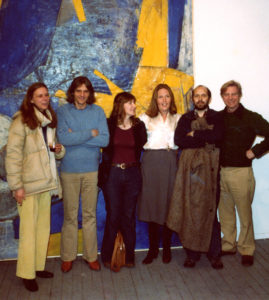
John at Fanelli’s, March 1978. Photo sent by Betty Cunningham
“John Walker is one of truest examples of a painter in the world today. As a student of his, he spoke almost laconically about what was most important about art and the discipline of work essential for developing our own voice in painting. He kicked my ass often and nearly kicked me out. I love and owe him so much.”
Rachid Bouhamidi
“John very graciously allowed me and my partner into his studio recently. It was a very great honour. My favourite Maine painter!”
Karen Jelenfy
“I remember seeing my first John Walker painting at the Virginia Museum of Fine Arts. It destroyed me. The texture, the builds, the scale, the deep and lush colors. So vivid in my mind all these years later.”
Polycarpe B. Thibodeau
“John said little in crits but what he said counted and was remembered. He cared deeply. He cares deeply.
I was a student of John at Yale 1991-93. What a pleasure it was. John exuded a love of painting. It resided in the very core of his being. And that rubbed off on me for which I am grateful. He said the last time we met in a gallery as I was taking down my paintings and he was to put up his. “ All this minimalism so people think you are thinking” he joked, to which I replied pointing to a large sports bag he was carrying with a hundred bingo card paintings; all these, so people think you’re working”. We laughed.”
Denis Farrell
“Master Painter. John has had a huge impact on my life. I studied with John at Skowhegan in 1989. I still put into practice the things he taught me. Amazing painter and teacher.”
Curtis Cutshaw
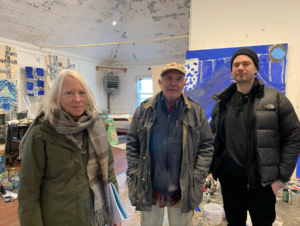
Studio visit by art historians Catherine Lampert and Alex Bacon.
“I’m an American painter. I was a hospital pharmacist, so I stepped into art rather late. I was one of 12 graduate students at Boston University, the first class that John selected when he began teaching there.
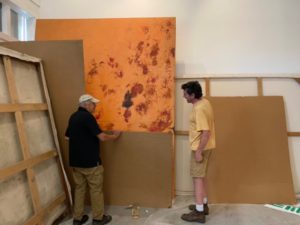
Studio visit. Photo by Gideon Bok
For me, it was a glorious two years of hard work, and I wished graduate school would last another year! I had so much to learn.
At the time, John was living in Upstate NY and drove weekly to Boston. He organized Tuesday evening guest lectures, visits from other faculty members, the poets at BU, artists and art historians from New York, in order to expand our experience. He did not want “his voice” to be the only voice. The Tuesday nights were our “Friday nights”. We would listen to John’s stories, about painting, about life, living in NYC “back in the day” about painters and paintings, etc. He is poetical and engaging in speech.
He began a book-making project which, over time, developed into a yearly project with the graduate poetry students. The results are stunning.
For each of the two years of grad school, he would generously invite us to his home in Maine, to paint the landscape. We painted like crazy, beginning at 6am and cooking dinners at 6 pm, enjoying an evening of film or conversation.
The opportunity of painting the landscape and being honest in observational painting, changed our studio paintings (even if we were abstract painters). We learned about light and the ever changing landscape of the rough Maine coast. To this day, often, I stop my studio work and paint from observation. It remains part of my studio practice.
We developed discipline. We built and stretched enormous canvases and ordered large pots of paint. Large paintings aren’t always the best for everyone, but the work involved to build those surfaces and to stand and confront a life sized canvas, is a critical experience. John wanted us to have that experience.
One comment, which he would repeat often in crits:
“The secret is to paint AIR. Paint the air. Give it air.”
John has affected many young painters and taught many students. HIs influence is enormous. He brings the importance of painting to the forefront, with a passion, a poetry, and a heroic force. It has been a privilege to have studied under him at BU and an honour to know him.”
Nadine Zanow
“As my teacher in Boston, John happened to give me with an insight and guiding principle that I carried through my life in my artwork, relationships, and my future plans. He stood back and looked at my painting, nearly as tall as me, fully painted, and suffering from realism, and said, “you have built the church, but you have not rang the bell.” I asked him to elaborate and he continued to explain that I have done so much work but not created the thing that rings the bell for the viewer. Since then, I have designed buildings, consulted on themed entertainment designs, and created many works of art with this in mind. I also brought that concept into my own life to gain more focus and live fearlessly. Thank you John. You have made a terrific personal impact on me on top of inspiring me with your life of art.”
Chad P. Forsyth
“John was a HUGE influence when he was artist in residence at Prahran in the early ‘80’s. He engaged with the students, shared his knowledge and skills, and generally inspired us all conceptually and technically. Total hero.”
Adriane Strampp
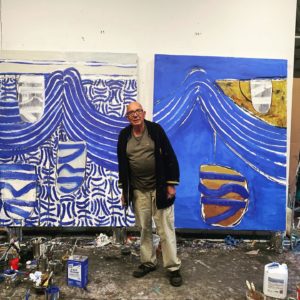
John Walker in his Maine studio
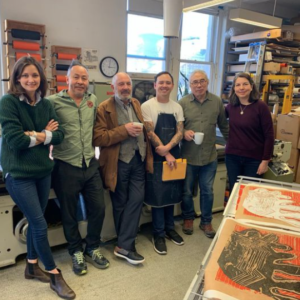
John Walker at his printmakers
“JOHN!!! I had loved his work for years and was absolutely thrilled when I got into Skowhegan in the summer of 1989 and he was on the summer faculty. He was a huge influence and one of my first supporters. I’ll never forget how often he looked at my disposable pallets, and with a sly smirk told me they were better than my paintings. I’m sorry to have fallen out of touch with John but here’s a huge hug from the past.
Another amazing memory from that summer. The talk you gave — I’ll never forget the Rembrandt portrait of Saskia holding flowers. You told us as painters we had permission to look at a painting however we wanted. As I remember it you didn’t speak about The Netherlands nor the 17th century nor Rembrandt nor really much about Saskia but only about the flowers. One of the most influential moments for me in an artist’s talk.”
Jane Fine
“When I joined John’s MFA program at Boston University my one main question was “Why make things?” But John never asked that question. Instead he asked “What is it?” when he looked at what I’d made. Nobody had ever asked me that. And I didn’t know. This opened up a series of other questions that challenged everything I thought I understood. During my time as John’s student I never had an answer to his first question so I took it with me. I continue to ask “What is it?” of everything I make.”
Lydia Musco
“I studied with John Walker at Boston University’s Painting Department from the Fall of 2013 to Spring of 2015. I was one of his last class and am honoured to say I was the last Kahn Award Recipient during John’s Illustrious tenure at BU. I was the last of his litter.
Working with John Walker at the graduate level is a lasting, rare and special gift that life has given me. John’s connection to the craft of painting comes from an intimate place –– a place of commitment, daily practice and mindful legacy. John’s approach to painting casts a powerful image of rigor and discipline, all the while his hand and teaching style is loving, dare I say tender, ever generous. John’s lineage of mentors (practitioners/teachers) goes back to the Renaissance –– that’s the level of embedded knowledge that John carries.
A fellow immigrant, John and I shared a knowledge of otherness to this country (USA) which I feel assists observation. John taught me that a great painter goes beyond developing mere style, rather a great painter gives you a new lens, “a way to see the world.”
When I think of my career, there’s a definite before and after studying with John.
John is earnest, steadfast and paints for more hours of the day than most people are awake. My commitment and love for the craft of painting has deepened, just in knowing John, I mean, he’s probably painting right now!
I am happy to say that in February of 2023 I celebrated my two year anniversary as a full-time professional independent painter — a milestone I am certain I would not have reached without John’s influence in my life. If I’m ever stuck in the studio, I like to think of John in his studio, trucking away, painting with his fingers, sipping wine and reading his paper. I wish to love painting as John Walker loves painting.”
Josue Rojas
“As a student of John Walker in 1968 at Birmingham College of Art & Design, it was a time of great change in our environment. John challenged our thinking by experimental project- based teaching leading our minds forward by explaining and illustrating new trends, methods and practice. I remember one instance where John presented photos of general advertising around the city of Birmingham, highlighting new vibrant colours and asked why we all were shy of incorporating these into our work, i.e., moving away for the traditional tonal fashion of earlier times. Another challenge was moving to extend our painting mediums from the tube of paint to incorporate some elements of utilitarian everyday materials into our work – it brought a new dimension to the creative process. During his time as our tutor, John believed that Art History education should be interlinked directly with studio practice. I incorporated this belief during my life and it is an enduring gift from my education at that time. John always supported his students to move forward and find their strengths and fought to raise their credibility and confidence. He even went so far as to challenge the local councils in their major development of Birmingham, to use the talent and skills of the students to create artwork across the city. You always felt as if he wanted you to reach your best and stretch your capabilities as far as possible. John is a passionate painter and a British Ambassador of painting across the globe. He has maintained his painting integrity throughout his painting & educational career and continues to evolve to new dimensions himself – practicing what he has always taught. John Walker deserves great credit for his contribution to painting locally and internationally
We were very fortunate to have John as our tutor in our formative years.”
Martin Dickens
“I cannot overstate how important of a teacher and mentor John has been in my life as an artist. As my teacher, he modeled what it meant to be a serious and disciplined artist while equally emphasizing the importance of generosity and kindness towards others. John has said many things that have driven me to work in my studio for years. Some of his most powerful words were simultaneously complex and deceptively simple. For instance, I can recall John saying:
“Make something that you have never seen before- make something completely original. “
John’s teaching alone could fuel an artist for a lifetime. But, what is even more fortunate, is that he continues to make a body of work that is deeply profound and and an embodiment of his continuous process of radical reinvention.
It has been a privilege to know and work with him.”
Matt Phillips
Dear John,
I wish I could be with you to celebrate The Blue Series. Listening to jazz as I write this brings to mind the importance and complexity of the blues in our culture. Calls and responses; spaces in-between; intense emotions. You are among those whose unflagging commitment to painting, and equally unflagging curiosity as to what painting can be, has helped to keep the discipline alive, as jazz remains alive and expansive.
Some of this is through your teaching. Your salient role as an instructor throughout the world has echoed your life, in which painting has played so central a role. While embracing conceptual and abstract considerations, your reimagining possibilities presented by the world around you embellishes your presentation of a universal moment tied to both history and future, now as always.
Beyond that, your gentle to explosive exploration of what paint can do has expanded our sense of opportunities there, pushing the medium and processes further in diverse directions: dense opacity to liquid transparency, and myriad options between. Equally so with color, your palette presents the moods of a rich and ever-changing life.
Please keep it up my friend.
With warm wishes,
Ruth Fine
Curator of Special Projects in Modern Art, National Gallery of Art, Washington
“I spoke with John [Walker] about my plans to study religion [at Harvard Divinity School]. . . My shaky voice could not formulate the words. I sounded so meek and ill-prepared. Then he looked at me and his eyes looked unusually green. . . He told me, “If such ideas are in your heart and you find yourself unable to articulate them, they are probably the best kind.” Then came the story: He was invited to a fancy dinner. . . Guston was there. He was the youngest amongst heavy-weights. This woman was married to a [Jewish] erudite who was at the peak of his academic career. At the table, he announced that there amongst them [intellectuals] was a man who was a believer [in God]. “It’s John,” he said and at that young age, John W had to defend his faith. This man said this in an attempt to humiliate him. So I realised that paintings, sincere paintings, do not lie. It was in his paintings that I knew of his faith just as I knew of Michelangelo and Van Gogh.”
SoHyun Bae
From SoHyun Bae’s Sketchbook, January 19, 1994
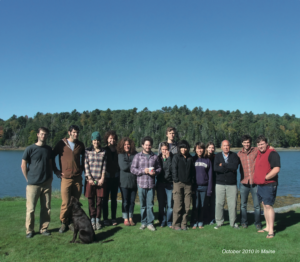
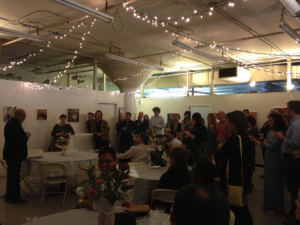
Boston University seminar classroom, 2013.
On the eve of the graduation ceremony, John spoke to the graduating students about the inheritance of art.
As John’s former student and assistant, I was lucky enough to work with him for several years. It felt unreal for an ordinary painter like me to be close to such a talented, successful artist. When you learn from him, you will always marvel at in the days, months, or years to come by his amazing insight. His tact, his patience, and his generosity to others made him a great educator. Yes, he changed my life. What he taught me about art, those days in his studio, was and will be an inexhaustible creative source for me.
Ying Zhang
MFA at BU in 2009-2011
“It could have been the autumn term, 1972, high on the top floor studios at St Martins School of Art when we first met John Walker. The other artists teaching in the Painting Department at that time alongside John were Freddie Gore, Gillian Ayres, Harry Munday, John Edwards, Jeremy Moon, and Albert Herbert amongst many others. Albert Herbert had taught John whilst he was a student at Birmingham.
So in these studios overlooking the Charing Cross Road, this quiet and serious man was engaging with students, listening to what they had to say and making informative and insightful remarks concerning their work. Gradually, we got to know John and in intimate tutorial sessions with small groups of students he introduced us to artists working in New York. These artists were Al Held, Elizabeth Murray, Alan Cote, Joe Zucker, David Diao, Brice Marsden, Jake Bertholt, Ross Blecknor and many more.
This introduction to new artists excited and expanded our knowledge and approaches to the subject of art and painting, which fed directly into our work. John Walker was sharing his experience and knowledge of working in New York with these young students in his own inimitable manner.
In the early 1970’s John had an influential show at the Nigel Greenwood Gallery near to Sloane Square. The work in this show consisted of large chalk drawing executed directly onto the walls of the gallery – it was the first site-specific work I had ever seen. It also included individual drawings and a well-designed catalogue. This was an impressive show and made a deep impression on many of us students.
Over a period of 8 years between St. Martin’s and the Royal College John was my tutor. In our tutorials, he enthused about Goya and Velasquez, encouraging me to go to Madrid to see these artists, who were referenced in his own work at that time. John was clearly showing us the direct relationship between past and present.
In the second half of the 1970’s whilst teaching at the Royal College of Art, John played an important part in facilitating an exchange between Yale post-graduate and the Royal College of Art, forming friendships across colleges, many of which still exist today. During this period he won the John Moore’s in 1976. I too, was accepted for that John Moore’s and was very happy to be part of it.
John Walker demonstrated by his own example the importance of belief and integrity in the discipline of painting. This for me was part of his legacy to his students.
We were very fortunate to have John Walker as a teacher, lecturer and artist. His wisdom, intelligence and insight remain with me to this present day. Thank you John.”
Stephen Cooper and Vanessa Jackson
“I can attest to John’s generosity as a teacher and as a human. In grad school he was always willing to visit my studio whenever I was looking for feedback or was in a rut. In my 2nd year as I prepared to TA my first class ever and felt clueless as to how to be a teacher his advice to me was just to have generosity towards the students. This simple advice from him aptly describes my experience having John as a teacher, and then a few years later I experienced his generosity as a human. When I experienced a great loss and he learned of it, he and Kayla offered me a place to stay and also to make art. The time I spent there was not only a period of healing but also allowed me to make work that became a backbone to the imagery that I make to this day.”
Jackie Feng
“I first met John Walker in 1988 as a student at the New York Studio School when he was a visiting artist.
Short, sharp, cutting, warm and hilarious. As a visiting artist to the New York Studio School, John had a particular gravitas and when he warmed to my painting it helped me find my feet in both the school and city. While always very supportive, he was also ruthlessly keen eyed to point out both my strengths and weaknesses as a painter. Moreover, John’s broad knowledge supplied a rich source of artists and shows to drive and provide a foundation for my practice.
Being from Sydney, I wasn’t up on all the New York painters that John clarioned, and once in frustration he cheekily remarked, ‘Haven’t you got an art education!’ to which I replied, ‘not for regional American painters.’ My weekly conversations with John were an important sounding block for my painting experimentation and development.
John was very generous with his time to the students and he would often take a couple of us out drinking. This activity was always fun, and not only for the beer.
As the rounds progressed John’s stories of famous artists would become richer and richer to our collective delight. Bad luck for anyone who wasn’t present, as these x-rated tales are under a cone of silence.”
David Serisier
“I feel truly fortunate to have been part of such a dynamic graduate painting program at Boston University filled with talented faculty and students. As the Director, John selected talented students working in a wide variety of ways, providing us students with access to diverse approaches to art making and differing values in art. John set up an action packed graduate program, some of the many highlights included landscape trips to his place in Maine, Tuesday night non-art related lectures, movie nights, a constant stream of visiting artists and lectures, trips to museums and galleries, collaborations with poets, the list could go on and on. For me, it was one of those rare times in life when I knew how very special an experience was whilst still in the middle of it. John has been such a great example to me of what a truly successful life in the arts can be like, I’m not talking about success in terms of fame and fortune, although some of that would be nice :), but more importantly I speak of John’s values. John led by example, working exhaustingly hard in the studio, most nights on my way out of the studio I would make a slight detour down the hall where the faculty studios are to spend a few moments with some of John’s paintings in-progress setting in the hall outside his studio, it was inspiring to experience the power of his work and witness his prolific output. John shared stories with us of his humble beginning, coming from little, John knows the true privilege it is to live a creative life. Laughter and play are highly valued by John, the way he likes to joke around and how he wears his childlike enthusiasm for life and art on his face is infectious. John is generous with his time and knowledge. He would check in on us all regularly to see how we all were doing. There were so many times when I noticed how John would see a student in need and he would help without being asked. I remember him dropping off large cans of paint to a student who wanted to continue to paint thickly, but couldn’t afford to do so. Money was tight for me too during grad school, on a group bus trip to New York a bunch of us went to breakfast at a diner near the Met, when I opened up the menu I was shocked by the prices, perspiring, I looked for the cheapest item on the menu. I ate an eight dollar half of a grapefruit fully loaded with sugar packets for breakfast that morning. Before the group departed to visit the museums for the day John pulled his MoMA membership card out of his wallet and handed it to me. That kind gesture allowed me to eat a decent meal that day. This was just one small instance in the long list of times John showed me that he cares. John loves to celebrate in the successes of others. John shows top notch hospitality, he introduced me (a jock from the hood) to Maine lobster and Chinese duck. John cares for those around him like family. I loved to look at the wall of family photos he kept that were sent by former students. There is so much more I could say about how great a person John is, I could write a novel, but I’m a man of pictures not words.
My mind and my eyes greatly expanded while studying with John and the other dedicated faculty members at BU. I experienced so many new things and have had so much to process after leaving there. I now teach art in the Washington DC area and am now passing forward some of what learned from John. I was taking my students through The Phillips Collection last summer when we happened upon one of John’s paintings. We all had a great time examining, admiring, and talking about the piece. I then told the students that John was my one of my teachers and at first they didn’t believe me. I guess I still have a lot to learn.
I have one final memory I’d like to share. One evening John came out of his studio with a big smile on his face. His entire hands were stained a deep green, in his long sleeved shirt, it looked as though he had switched hands with character Shrek. The students all started laughing, and then we began saying lines from the film in the character’s voices.
As I wrote on the back of the painting I gave him upon graduation – Thank you for everything John.”
Mark Thomas Anderson
Class of 2009
“My initial introduction to John was as a prospective student at Birmingham College of Art for the Painting Dip AD program. He asked me who was my favourite Painter. I knew then that this was a serious program that I wanted to be a part of.
Sixty years on from student to friend we have remained involved, in contact and I have been privileged to share in his painting history from that day forward. Generosity is an integral part of John’s work and passion. So much of what he seeks is expressed in multiple visual ways from series of related paintings, drawings, prints and sculptures.
For me he is the true Painter’s Painter, standing in front of one of his works the journey of its creation is revealed in its entirety and rightness. Not swayed from Art world fashion and or dogma his works are exceptional in their quality and individual visual qualities, not illustrative of ideas but arrested from the act of painting itself and the inherent multiple prompts it reveals.
Over the sixty years I have known John I would need a book format to comment on his work and creative endeavours. Suffice it to say I hope these few comments help.”
Graham Campbell
“My name is Chris Chou, I am John Walker’ Student in BU from 1999-2001. It was a high light for me to study painting in the MFA program. John is a great painter and also a good teacher.I just enjoy to be with him. Wish John has a wonderful and successful exhibition in London!”
Chris Chou
Former student at Boston university 1999-2001
“I studied with John Walker at Boston University from 2003-2005 while getting my MFA. I went to Boston specifically to study with John, I was already inspired by his work, his sensitivity in exploring material qualities in his paintings and prints, in essence creating precious objects. It was a tremendous privilege to study with him for two years and learn more about how he looked at creation. It taught me to further explore personal narratives, history and a love of beauty–although that is a very loaded word… In the end his example is one of a passion for creation, for making beloved objects and he continues to be a giant inspiration. And, as an educator, the care and pride that he shows for his students is something that I work towards everyday.
I hosted him for an exhibition at my college in Fort Worth, Texas in 2013–it is actually the 10 yr anniversary of the opening. I am attaching a picture of us at the show. Also, my most cherished memory from his visit was a moment after dinner where he and my then 5yr old daughter did some collaborative drawings. It was just further evidence of how much he enjoys the process of creation and sharing this passion with others.
I could easily talk much more, but I don’t want to monopolize this. I’m also sharing 2 images from what my art practice has become–a love of making objects/artifacts, storytelling, personal narratives, connection to the land and history–very John inspired.”
Joshua Goode
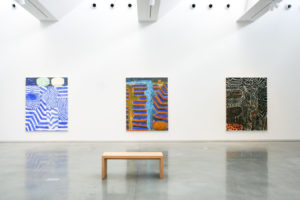
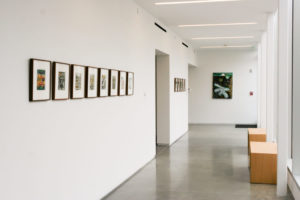
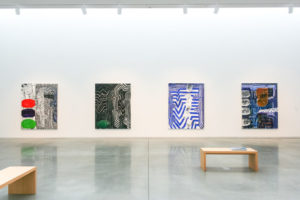

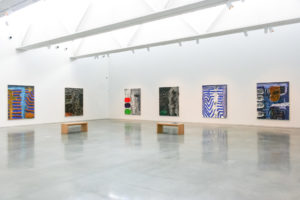
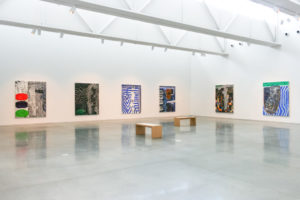
Photos (above): John Walker, ‘From Seal Point’ held at the Center for Maine Contemporary Art in Rockland, Maine, from June 24 – October 29, 2017. Sent by Suzette McAvoy, writer and curator.
“I went to BU to work with John after seeing his paintings while a student in Mexico. I had a friend at Yale who introduced me to his work. After seeing his paintings I felt that there was something in them that was special, unlike anything I had seen. I trusted that feeling and went to BU. A few weeks into my first year, John invited me to his home to paint from the landscape. I had never painted outside my studio walls. Needless to say, it changed everything about my painting. I did not become a landscape painter but it gave a new set of eyes to look at the world. Many experiences with John have done that: a studio visit, a trip somewhere, standing in front of Goya or a conversation in his studio.
One year after I graduated he invited me to join BU as a teaching fellow at the graduate school. I was participating in all of the activity at the school, but not as a student, with John as a guide and colleague. These were my most significant formative years – he taught me how to be an artist.
I fell in love with painting because when it’s great, it always surprises! You never know how you will feel in front of it, how it was made, how it will resonate once you are not there. I feel like that about John and his painting. It (he) is always surprising – I do not know how I will feel, how it is made what it (he) will say and how it will impact me. The one thing I know is that it (he) will give me a new set of eyes to look at the world. And for that immense act of generosity, I am forever grateful.”
Alfredo Gisholt
“I was an MFA student of John Walker’s at Boston University from 2004-2006, the most pivotal experience on my path as artist to date. John kicked off the semester with a mind bender of an assignment: “draw nothing.” This was followed by a range of projects – make a self-portrait the size of a postage stamp, make a life size drawing from the model using gesso and graphite powder and your hands for brushes…one day towards the end of the semester, he gave everyone a sheet of forty-dollar paper from his personal stash and said “this is really nice paper, go make a really nice drawing.” They were the best drawings we made that term. He taught us to explore materials and to think outside the box. On a late night when I was working in the studio, I caught a whiff of cigar smoke and John popped his head in. On seeing I was struggling, he offered a brilliant suggestion, “Make the same painting three times, on three different colored grounds and see how that affects them.” It was like magic when I painted on a Cadmium Red ground, a depth and glow from within, and a practice I keep to this day. He taught us that art can be made with mud, scraps, and found materials, and also encouraged a splurge on high quality paint and brushes when the work demanded it. There were no limits. A generous and demanding teacher, John looks from all angles, thinks from the inside out, and is relentless in his pursuit to always go deeper, always work harder, and always seek the edge that makes something rendered, something more.’
Elizabeth Livingston
“As a young painter, my introduction to John Walker’s work was a revelation, a transformative moment that opened up new horizons in my creative pursuit. I first encountered John’s mesmerizing Oceana series through my painting professor Diane Whitehouse, and the catalog of his paintings she passed along like a precious oracle, left an indelible imprint on my understanding of contemporary painting and creative imagination. Having first grown up during China’s Cultural Revolution and then in the barren prairies of Canada, the works were bold, masterful, and prescient, unlike anything I had ever seen before.
Years later, my dream of meeting John was realized when I enrolled as an MFA student at Yale University School of the Art. Upon learning that John would be one of the senior critics, I seized the opportunity to showcase my work to the maestro. In the weeks leading up to the critique, I toiled tirelessly, painting day and night, until my studio was brimming with freshly painted canvases and the smell of dammar varnish.
On the day of reckoning, I sat in my studio, waiting nervously for him to arrive. When he did, I was struck by his presence. John was a gentle-looking man, with a permanent but slight upturn in his mouth, as if he was smiling at something he saw but didn’t want to show it to you. He wore a classic tweed long coat and held a stumpy knob of an unlit cigar in one hand, which he sometimes licked, but not smoking it, throughout the critique session.
As he surveyed my freshly painted work, the tension built deep inside of me. I was anticipating and hoped for a revelatory insight that would point him in the right direction, but John remained enigmatically quiet, neither praising or criticizing my paintings. He mostly pointed to painters that I should be looking at. Most of whom I’ve already admired. This left me deeply frustrated and unsure of where to go next.
But as John turned to leave, he paused, his eyes lingering on one particular canvas. He then made a sudden, decisive move, reaching out with his cigar, and pointing at an area thick with colorful brushstrokes but otherwise vacant. “You know your painting needs something there to hold it together,” he said, then stabbed the canvas with the tip of the cigar. “See, that looks better already.”
As John left my studio, I sat in stunned silence, my mind racing with thoughts and emotions. I had received little verbal feedback other than the cigar stuck on the canvas, yet the brief encounter had left a lasting impression on me. Over the years, I continued to seek out John’s guidance, forging a close bond and admiration that lasted over three decades.”
Fred Liang, former MFA student at Yale University
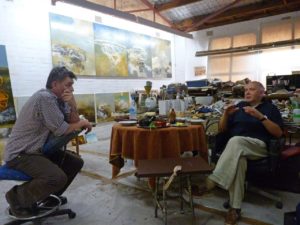

“Painter Philip Hunter, my late husband, was a student of John’s during his time in Melbourne and as the Dean at the Victorian College of the Arts, now the University of Melbourne.
John’s teaching had an enormous influence on Philip and a number of other artists. Philip observed John’s practice extremely closely and regarded him as his mentor. Apart from John’s subject matter, and drawing and painting methods Phil was also especially impressed by John’s work ethic, something that Phil absorbed totally and later passed on to his own students, including me. As Phil has said to me, he felt that John put him in contact with contemporary International art and art practice. John gave him his first job at the VCA in 1982 when Philip was only 21.
Philip Hunter was a painting lecturer at Prahran College and the VCA from the 1980’s through to the late 1990’s. Phil’s teaching and his own example did mean that John’s early influence was eventually percolating through to a group of new generation of Melbourne painters. I happened to be one of them.
I arrived in Australia in 1986 from Germany and had never met John, until he came to Australia with Kayla in 2011, and when they also visited our studio. (see photo: top left)
In 2017 John came back to Melbourne for the 50th anniversary celebrations. This was after Philip’s death in 2017, and John and Kayla kindly visited my exhibition.” (see photo: bottom left)
Vera Möller. Melbourne. Australia. March 2023
SPACER
“John Walker’s legacy has been very considerable and enduring in its impact for someone who spent relatively little time with us as Dean of the School of Art, the Victorian College of the Arts, Melbourne, Australia in the 1980’s.
John came to us as an eminent, highly celebrated artist with an inspiring international reputation. Yet, despite this profile and probably precisely because he had nothing to prove, he leant a quiet, humble, knowing authority in his leadership of the school. He was a dynamic, enormously insightful, and perceptive teacher and an enthusiastic and encouraging mentor who had time for all students and was an important catalyst for launching many artists’ careers.
The 80’s was a time when painting was in its ascendency internationally, – far from ‘dead’ – painting came to represent an important intersection between new ways of seeing and a seemingly traditional way of making art. This coincided with the height of postmodernism and paved the way for a proliferation of cultural and sub-cultural tendencies such as (post) feminism, (post) punk, collaborative practices, Artist Run Initiatives etc. to loosen the conservative constraints of the local art scene, offering greater opportunity and agency to younger artists and students. It was, in short, an incredibly exciting time that was made even more fabulous and dynamic in Melbourne with the establishment of 200 Gertrude Street.
It is no exaggeration to state that John lead and was largely responsible for this initiative – I know because I was on the initial working party along with other staff and recent graduates to get the Gertrude Studio Spaces and Gallery operational.
It was John’s foresight, and I am guessing his knowledge of PS1 and Kunstlerhaus Bethanien like organisations and their benefits and opportunities, not only for young artists and recent graduates but aspiring curators, gallery directors and writers that galvanised this project.
By provided studios and exhibiting spaces with an international, contemporary art focus, Melbourne was on the map with the Gertrude St and on the way to building an Iconic Melbourne Institution that has over many years contributed enormously to the ongoing and healthy eco-system of the Melbourne Art Scene – and of course has also had a tremendous impact nationally and internationally.”
Jan Murray
“I met John in 1989 at the Skowhegan School of Painting and Sculpture, Maine. One of the memories that stands out during his studio visits was when John asked me what artists I was looking at – I shyly mentioned Thérèse Oulton’s paintings as being influential. He then asked me who Oulton looked at; naturally, I had not thought about that. After the studio visit, we walked to the library, where John pulled several books off the shelves: Nicolas Poussin, Claude Lorraine, Jacob Van Ruisdael, and others. He did not say much, but I remember him pointing to specifics in certain paintings. The library visit was a significant learning experience, maybe because I was ready to learn and see the world differently. A few days later, he arrived at my studio with several tubes of the most beautiful Australian Spectrum oil paint. I still have one of the empty tubes of Italian pink pinned to my studio wall. The color was transformative in my work. It alleviated the choaked reading of my earlier paintings. I can, even now, feel the excitement of the moment he showed me how to use the colors (especially Italian Pink) in my work. He also contacted his gallery in New York to send him catalogs of Thérèse Oulton’s paintings, which he gave me, and I later shared them with my students.
I am a painter (and Professor) today because of John’s teaching, insights, and generosity from that summer. I owe my work ethic (at least partially) and deep love and understanding of the materiality of paint to John. He encouraged focused work that summer, and I was determined to prove a point and make worthy paintings. I felt understood and grateful that he comprehended the significance of my West of Ireland background to my work. There are other stories and memories from that summer, such as the time John allowed me and a friend to visit his studio – our exhilaration to be in his world of painting – alone.
Through my younger eyes and awareness of the art world, John seemed to understand paint viscerally, on a deep level. I knew I would need to live and work as a painter for a long time before I could venture into teaching or exhibiting my work. Even then, I was doubtful I could do it.
Teaching and making paintings is his lived experience.”
Helen O’Toole
“I was John’s student from 1993-1995, when he began teaching full time at BU. I was in my 30’s, had graduated from an art school ten years earlier, had been teaching studio and art history as an adjunct, working out how to be a painter. But I came to recognize that those years working with John were actually my first steps in painting the works I wanted to make.
When John became a full time professor at BU the program was in transition, operating at nominal level in many areas. Quietly, almost privately, John created numerous significant changes that would elevate the program to become equal to the best graduate schools in the country.
Drawing on the support of artists, writers, museum curators and gallerists primarily from New York John personally re-made a virtually non-existent visiting artist program, transforming it into a program of prominent weekly visitors who gave talks and met individually with students. The numbers of visitors alone were extravagant but the outstanding quality of people who came did it in support of John.”
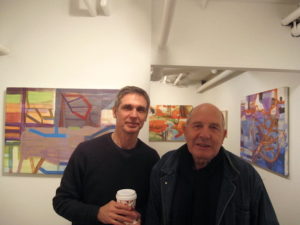
John Walker with Russell Roberts
“John also created a weekly evening “salon” series- as he called it – inviting BU and other university’s faculty, plus area artists, printmakers, writers, poets. classical musicians, performers, an opera singer, scientists and doctors, even a meditation yogi. Basically John invited anyone whom he met that he felt had something of substance to offer.
On other evenings John would bring out his collection of slides for “cigar box” lecture-discussions that lasted as long and late- very late- as people stayed.
John also brought artwork that he owned and pieces from his extensive collection of aboriginal art to the grad studios, setting the works out in the common areas and letting students work from those pieces in their own studios over weeks and months.
John set up his own painting studio down the hall from the grad studios. It’s distinctive smell of Haerem oil paints, MSA gel, solvents, flasche and cigars permeated the floor.. He produced more work than anyone in the program in less than half the time. Seeing the work in his studio was itself an aspect of his teaching.
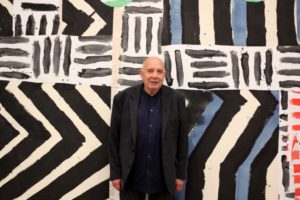
John at Ikon in 2019. From Jonathan Watkins, director at Ikon Gallery.
In these and other ways, John turned the grad school into a 24/7 immersive environment; no clocking in and clocking out according to pre-scheduled time slots or making artwork inside academia. For those two years it was all-in. We were pressed to understand what ambitious painting was, what it entailed — including the necessary hours in the studio -and to aspire to it.
His seminar assignments were unique, seemingly without theory, straight forward but actually far reaching and improbably, they contributed directly toward making more interesting studio work. One assignment asked students to find, photograph and present a series of works or objects that you could see first hand that you “weren’t sure if they were or were not “art.” I heard terrific lectures from that assignment. One lecture focused on the gargoyles in the collection of the Fogg Art Museum. An annual second year assignment was to make an artist book- absolutely no guidelines or limitations except that it had to be held together by a functional binding.
John never advocated a way to work or one type of art over another, The range of work among the students proved it and contributed to the best of the studio’s culture, especially in group crits. There was no BU look. John always spoke last in group crits. Everyone had to make their points before he did. Over and over John showed us what was important in those overlooked students’ works. I remember many of those. At the same time, John could be uncompromisingly honest about work yet the criticism never seemed personal or gratuitously harsh.
Somehow John could be simultaneously taciturn and expansive. John always spoke to the specific work. I had individual crits that lasted only minutes and that seemed best. In one crit he taped off a small area of a painting then left without anything said. I looked at that taped rectangle for days until I recognized what was in it that was unique to my work and how it offered a way to go forward.
John entered studios so quietly that often you wouldn’t know when he was behind you- or for how long he had been there. Maddening.
He was known for homespun anachronistic British expressions- I used to be told – “No pudding there” Everyone had their own.
In the last weeks before graduation I had been reworking one painting repeatedly. John came to the studio and decided to help this once: He put his thumb in the paint on my palette, touched the canvas in three places, making three small daubs, and the whole painting opened up: it became structural, spatial, filled with light.
After graduating from the program I taught and often drew on John’s teaching methods. I was fortunate to have studied with John. It was a seminal period of my development as a painter and a teacher. His artwork continues to be part of my studio dialogue. He has been a mentor teacher and friend for close to twenty years.”
Russell Roberts
“We have been friends for close on 50 years and I am privileged to call him a friend. I think he is a really great artist and have never understood why he is not better recognised. I think one of the reasons is moving from the UK to Australia and then USA and being out of the local environment. I hope your exhibition will go some way to reverse this situation!!!
As far as anecdotes are concerned, many are not suitable for public discussion, but I will just mention one. About 40 years ago John and I had an interest in a racehorse which was called Reelia Godess because of its sires name. I paid John’s share, and he gave me a painting for this share. I wrote this name on the back of the painting. I am now waiting for some critic to work out the basis of this name and some deep psychological meaning!!! The horse was not much good, but did win one race.”
David Rosenthal
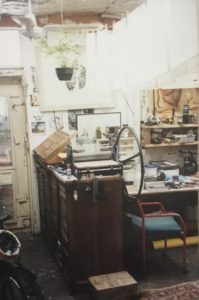
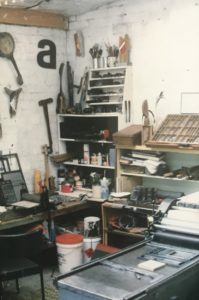
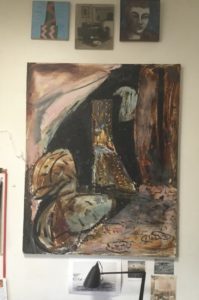
John Walker’s old studio in North Carlton, taken over by artist John Ryrie. An unfinished painting by John Walker
“I was a student of John’s at the Victorian College of the Arts Melbourne in the 80s.I took over John’s studio in Canning Street North Carlton in 1988 and stayed there for about 12 years.”
John Ryrie
“There are very few artists who have the generosity that John has always manifest, in his painting and his life. (Is there any difference?).
As with any truly great figure there are many reminiscences that flood your memory, and that’s how it should be. That’s because they left an indelible impression.
I don’t particularly like to use any one single anecdote but this one may illuminate John’s greatness.
John was invited as a guest to a place where I taught. Everyone was excited, students, faculty, even the entire damned administration. John conducted critiques and it went beautifully. Few can inspire, articulate and accentuate the greatness of Art like John Walker.
Afterward we sat in his suite, looking over the lake, drinking a glass of wine and having a cigar, relaxing and talking. It was wonderful to be there with my friend, just enjoying his brilliance. Imagine sitting with Picasso, one of your heroes and how tremendous the opportunity. Well, one always feels that way in the presence of John….
Nonetheless, we sat on the veranda relaxing and the director’s wife appeared. She said that we must not have done a very good job because none of the students were crying…….
John was appalled and in short work told her how distorted her priorities were, how twisted her ideas, her humor and how mean-spirited such a comment was. Painting, Art was an act of love and that search wasn’t not a debasement of another and their vision.
How great is that? How great is that man? How could anyone not love him?
With John, I’m always reminded of that quote by Edith Hamilton- Men knew great deeds could be done because they had seen great deeds done by men.
I’ve seen great deeds…………….they were done by John Walker.”
Ed Smith
National Academician, National Academy of Design, Director Marist Venice Biennale Program (Friend and fellow tutor of John Walker)
“I met John Walker in the mid 1980’s. He and his work have been an inspiration to me since that time. He is a painter’s painter. Looking at a painting of his, it’s visceral, I want to immediately get to the studio. To me, his paintings are about the earth – it’s ebbs and flows, changes, weather, growth. It’s as though the paint comes from the earth and he picks it up and uses it to make a painting. His hand is weighty and sensitive which make his paintings John Walker- Epic Masterpieces. I get inspiration every day from looking at John’s paintings. He is my painting hero.”
Gwen Strahle
Visiting artist at Boston University
“Years ago, in a back room of the old Nigel Greenwood Gallery, I peeked a look at one of Walker’s enormous, heavily-impasto laden Alba paintings, propped against a wall. I’d have loved tohave snuck out with that painting carried on my back.”
Hitesh Teli
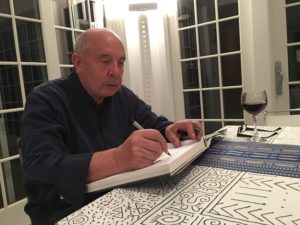

“I worked (in an administrative role) with John at the Boston University School of Visual Arts from 2003 until his retirement in 2015. I visited him a couple times at his Maine home, the most recent being 2018, when I took the attached photos. He’s definitely among my favorite artists–a true painter of the earth. I’ve been lucky to see his work in person many times over the years, in New York, New Haven, and of course in his Boston and Maine locales.”
Logan Zimmerman
John Walker at home and in his Maine studio in 2018. Photos by Logan Zimmerman
“I met John Walker in the early 90’s when was a visiting artist creating work in our monotype workshop. His work blew me away and a year later, I joined him in Boston for graduate school. This opportunity changed the direction of my life and I am deeply grateful for his advocacy.
John brought a depth of understanding and passion about painting that I had never experienced before. He was a generous teacher, sharing his community of artists, curators, historians, and scientists with us. Those studio visits and evening talks were not only informative, they also gave us license, humanized celebrity, and demystified success.
John did not only share his community, he shared his home and studio in Maine. For about a week, we stayed with John and painted. This was the first time I painted en plein air. Watching him and my peers internalize the complexities of the observed landscape and translate it with a contemporary lens, liberated how my young self defined painting.
I still paint seriously and have found a way to build a studio-adjacent career in the arts. I am currently the Education Program Director for Golden Artist Colors in upstate NY.
John and I share a birthday which is the perfect excuse to check in periodically and let him know I am still grateful.”
Stacy Rosende
Boston University class of 96
I was a student of John’s at BU from 2009-11. He is the real deal. He didn’t care about anything besides making his work better, and if you were his student, making yours better too. Not all the students liked him, but the ones who were serious artists did. He was strict about having us work every day. He used to blast “Sultans of Swing” by the Dire Straits in his studio constantly — even if he was in there for just an hour or so. I know because mine was on the other side of the wall. I miss the energy and the sense of creative community he fostered.
Daniel Herr
This photo is on the shore of our former villa on the Maine coastline, a property that John personally helped us choose. Later, this home served as a residency base of the Inside-Out Art Museum, receiving many painters from mainland China. They are still feeling inspired and influenced by John today, and because of this residency program, the painters who visited all have fond memories of interacting with him.
Jerry Huang
Founder of Inside-out art museum in Beijing
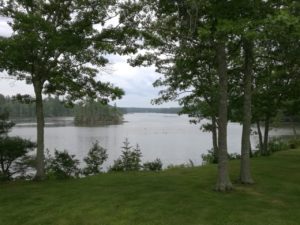
Photos sent in by Jerry Huang
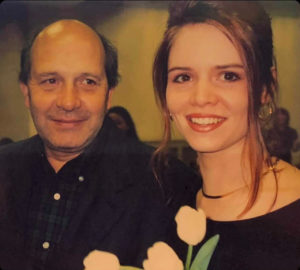
Photo supplied by Amy Jones
John was great, so memorable. He supported his students: he helped me get into the Vermont Studio Center for a month long residency. He helped pick me for having good studio progress-prize was oil paint.
Chaim Soutine’s catalogue raisonne by Taschen was influencing my work in grad school. John had the idea of bringing me a pig’s head from his butcher to add to my still life. I thought the world of him for that pig’s head! We’d freak out all the visiting artists by getting it out of the freezer and letting them take a look. I got to use a real human skull he had from a doctor friend. He said doctors are often painters: They’re the ones with the crazy socks. Also, He brought me goose eggs. So I painted dead studio rats and gutted a chicken for a Soutine inspired painting.
John liked The Rolling Stones over the Beatles. Pretty cool cigar smoking, beer drinker painter. Everyone will say he’s a painter’s painter & he’d make comments about the excitement on the palette but it needs to be on the canvas. Lol
Amy Jones, the Texan
MFA Student at Boston University, 1993-95
I was accepted into the 2 year Post Graduate Painting course at the Victorian College of the Arts in Melbourne in 1984; I was 22 years old. John Walker was the Head of the Art school; he had recently moved to Melbourne from the UK to take up this position. He brought with him a reputation and a history of international art production and exhibiting. He was dedicated to his painting and led by example maintaining a studio at the Art school.
On entering my studio one morning, there was a note on my table from John that read, ‘Where are you? Come and see me in my office’. I proceeded to John’s office where he said ’Every time I come past your studio you are never there, are you serious about your art studies? ‘ ‘If not, there are plenty of others who want the studio’
I could not believe what I was hearing and was so pissed off. I was totally committed. While I will admit I was rarely in the studio at 9am when John came by, I was there 100% the rest of the time. I thought, I’ll fucken show him!
I did successfully finish the course and embarked on my art career. It was years later when I realised John had high expectations and was giving me a kick up the arse to go harder. It worked! And here we are.
Jon Campbell
I had an opportunity to study with John for a month in May 1994 while he was a visiting artist at the Vermont Studio Center.
Then, in 1996, I had an art show up during his return to the VSC.
Arista Alanis
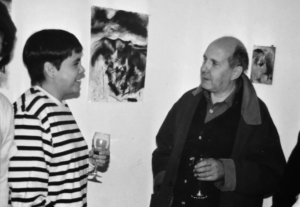
Photo of Arista Alanis with John Walker in 1996
I first met John in 1969 he was the Gregory Fellow at Leeds University and I was a Fine Art student at the then Leeds Polytechnic. The artist and now renowned jazz musician Kate Westbrook was a part-time lecturer, and arranged for John to talk to some students. He invited two of us to visit him in his studio and to the subsequent opening of his final exhibition. Two parallel characteristics emerge as an established pattern down the years: the quality, scale and ambition of John’s work and the spirit of generosity and support he has given to students and young artists. In 1970 I visited New York, where John was on a Harkness Fellowship, and was again invited to his studio and to meet some New York artists.
We have subsequently remained in contact over the years. In 1985/86 John, then Dean of the Victorian College of the Arts in Melbourne, invited me to be Head of Painting. The notes above remain pertinent, in that John had a studio next to his office, where students were occasionally invited to view his latest work.
I could go on, but suffice to say that it’s been an honour and a privilege to have known John for so long and to witness his sustained commitment to his practice.
Paul Rosenbloom
Around about 1996 I had one of the most astonishing studio visits of my life. A pair of us from the Boston University Art Gallery were planning on a solo show for John Walker. He was then teaching in the graduate painting program at BU, but his primary studio was still located in an old drydock in the mid-sized Hudson River Valley town of Kingston, New York. Like so many other places in that area, the riverside building that John had called home and work for much of the 1980s, had seen better days.
We visited in winter, just to had a bleak pall over our approach that day. Being young and prepared, I had studied what images I could find of John’s work to date. Strong, painterly abstractions often teetering somewhere between the minimalist ideals of “objecthood” and expressive figuration. None of that prepared us for what we encountered as we entered his cavernous studio on that grey afternoon. Just thinking about it reminds me still of the power of art to spark personal epiphanies.
Leaning against the walls all the way around the studio were paintings with bold, richly brushed words. The texts were brief snippets of poetry, and the images offered a summary of forms that had engaged John for decades. The paintings were both summations of his ideas and explorations into a new realm. There were so many new paintings. They were big, bold, and tended to be a bit dark. As John began to explain their origin, the personal history and emotional rawness of the work came into sharper focus. These were his World War I paintings and they were then, and are now, overwhelming. To walk into that building and be surrounded by these allusive giants was an experience like no other for me—one of the great moments in my life and for it I am truly grateful.
John R. Stomberg
Virginia Rice Kelsey 1961s Director
Hood Museum of Art – Dartmouth
I was not a John’s student. But through teaching, traveling, and even just a conversation over a drink with John I learned so much. In 2007 we were taking MassArt students to China. Before the group depart John asked all students: to prepare a the most beautiful drawing book you have ever had for the trip. Not a casual drawing book. For me take students to China for more than 10 years, I almost get use to the usual routines for the trip. But only one sample art material requirement from John, the MassArt’s China trip becomes more exciting and important. It was privilege I had been invited a few times by John as visiting artist and final review board of the Graduate Program for Painting at Boston University Art School. During that time, John mentioned a few times about the ten generations of painters from Michelangelo to ourselves. Although I couldn’t remember exactly how John puts the order in his talk, but I certainly always thinking ever since where I am and how do I make the order in my maid. I’m sure all of his students and friends whom heard this before are always think about that, too.
John Walker is a great artist, a wise man, and a very nice friend.
Yuan, Zuo
When John was Dean of the VCA, he employed several artists from outside the fully tenured academic cohort. I worked in Printmaking, and wanted to get painters interested, so started an introduction through monoprints. It was enthusiastically patronised and pretty messy.
One morning in fully flurry, the smell of cigar smoke announced the arrival of The Dean. John, in his good-natured manner, asked….”What’s going on here mate, kindergarten play time…?”
A few months later he made a huge body of monoprints and showed them under the title Salpituedes at Powell St Gallery. The prints were six feet tall and astounding. They reminded me of Munakata’s Disciple series at the NGV. No discrete little curios here.
John has that ability to see something, dwell on it, and bend it to his purpose, no matter what it may be… all is grist for his mill.
Ian Parry, Tasmania
When I met John I had very little studio experience but was full of enthusiasm for painting. Despite my inexperience, John treated me like an artist from day one and it’s not an exaggeration to say that his encouragement and support changed my life. As a teacher, John has a way of holding you to account while simultaneously letting you know that he believes in you and is rooting for your success. He’s a tough, caring, and immensely supportive mentor. I was lucky to study with John for three years, first at Brandeis then at Boston University – but you never cease being one of his students. To this day, nearly twenty-five years later, every time I get close to finishing a painting or hang a show, I ask myself “What would John think?” Ruminating on the work, I find that conversations I had with John at age 25 still help how I see my paintings today. He’s still teaching me all these years later and it’s a privilege to be his student.
Brett Baker